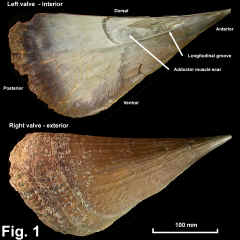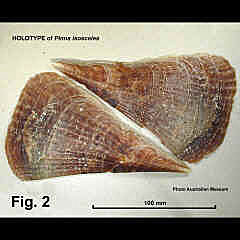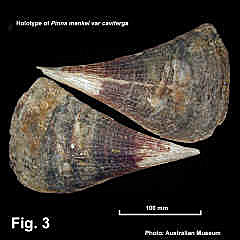|
|
PINNIDAE |
|
|
|
Pinna menkei Reeve, 1858 Description: Shell moderately fragile. Shape sharply pointed anteriorly, broadly rounded posteriorly, maximum height usually at 1/3 of width from dorsal margin. Dorsal margin slightly to moderately concave, ventral margin convex to weakly concave. Shell gaping at dorsal end and at byssal area at anterior-ventral margin. Hinge along anterior half of dorsal margin. Interior with nacreous layer occupying anterior half, divided into dorsal and ventral lobes by longitudinal groove; posterior adductor muscle scar on ventral half of dorsal lobe, anterior to end of nacreous lobe. Exterior with about 12 radial ribs on the anterior end, continuing or fading out towards the posterior end depending on extent of shell repair. Spines absent. Shell colour light to dark brown. Size: Up to 500 mm in length. Distribution: Endemic to Australia; Magnetic Island, Townsville, Qld, southwards to Jervis Bay, NSW (based on Australian Museum specimens identified by the author). Habitat: Lives vertically attached by the byssus to buried pebbles or rocks in sandy or muddy situations with only the dorsal margin protruding above the substrate. It is by far the most common member of the family in NSW, living in bays and estuaries, sometimes abundantly. It was previously common in Gunnamatta Bay, Port Hacking, Broken Bay and Port Stevens. Synonymy: Hedley (1924) described a small, regularly triangular form of this species as Pinna isosceles Hedley, 1924. The holotype is shown in Fig. 2. He also described a form from Fraser Island, Qld, with a more broadly rounded posterior end as Pinna menkei var. caviterga Hedley 1924. This is shown in Fig. 3. Both these names are previously recognised synonyms. As explained in the Introduction to this family, this species has been known as Pinna bicolor Gmelin, 1791 in recent Australian literature, including Lamprell & Whitehead (1992), but that name is now restricted to a species that occurs in the Red Sea and Persian Gulf. Fig. 1: Lilli Pilli, Port Hacking, NSW (C.50630) Fig. 2: HOLOTYPE of Pinna isosceles (C.44611). Photo: Australian Museum Fig. 3: HOLOTYPE of Pinna menkei var. caviterga. Photo: Australian Museum |
|


